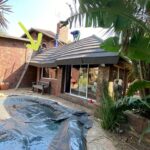Roof frames provide the structural support for the roof of a building. Different types of roof frames are used depending on architectural style, building design, and regional construction practices. Here are some common types of roof frames:
Common Roof Truss: This is one of the most widely used roof framing systems. It consists of triangular-shaped trusses made of wooden or metal members that provide support for the roof. Common trusses are versatile and can be used in various roof designs.
King Post Truss: This truss features a vertical central post (king post) that supports a horizontal tie beam. It is often used in cathedral-style ceilings or for decorative purposes in timber-framed homes.
Queen Post Truss: Similar to the king post truss, the queen post truss includes two vertical posts (queen posts) instead of one. This design provides extra support for longer spans and is commonly used in larger roofs.
Scissor Truss: Scissor trusses have an inverted V shape, with the bottom chord sloping upwards. They are often used to create vaulted or cathedral-style ceilings and provide an open, spacious interior.
Gambrel Truss: Gambrel trusses are commonly used in barns and resemble the gambrel roof shape. They have two sloping sides with a steeper lower slope and a shallower upper slope.
Howe Truss: The Howe truss features vertical posts with diagonal members forming an X shape. It is a versatile design that is used in various roof configurations, including gable and hip roofs.
Fan Truss: Fan trusses are characterized by radiating members that fan out from a central hub. They are used in circular or polygonal roof designs, such as in some churches or event venues.
Bowstring Truss: These trusses have a curved or arched upper chord, creating a bowstring shape. They are often used in industrial buildings and gymnasiums to achieve wide, open spaces without interior support columns.
Flat Roof Truss: Designed for flat or nearly flat roofs, these trusses have a horizontal top chord and vertical web members to support the roof structure.
Mansard Truss: Mansard trusses are designed to support Mansard roofs, which have a double slope on all sides. These trusses are often used to maximize attic space in residential buildings.
Parallel Chord Truss: Parallel chord trusses have two parallel horizontal chords connected by diagonal web members. They are commonly used in modern and industrial buildings.
Scissor Roof Truss: These trusses have two bottom chords that intersect in an X shape, creating a scissor-like appearance. They are used to create vaulted or cathedral-style ceilings with a central ridge.
Raised Heel Truss: Raised heel trusses have an elevated bottom chord at the wall connection, allowing for additional insulation and ventilation in the attic space. They are energy-efficient and commonly used in residential construction.
The choice of roof frame depends on factors such as architectural style, span requirements, building codes, and the desired interior space and structure aesthetics.
We provide thatched roof regulations for owners of thatch lapas, thatch houses, and thatch roof construction

